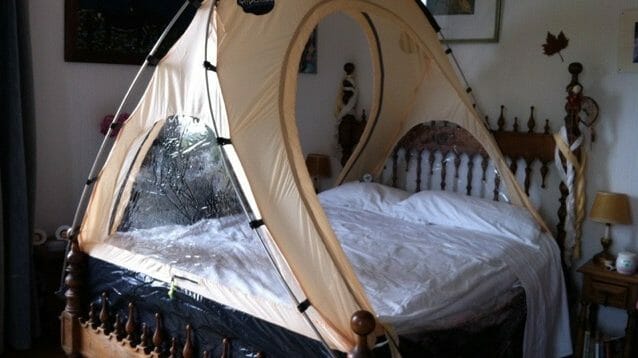While working on our article “Training, Oxygen Systems, and Hypoxic Tents: Success Factors for Climbing Mount Everest and 8,000-Meter Peaks,” about climbing 8,000-meter peaks and the use of normobaric hypoxic tents to pre-acclimatize, Dr. Monica Piris spearheaded the research effort. She culled the recent editions of High Altitude Medicine and Biology and conducted searches of Pub Med and PLOS One to find all publicly available articles about intermittent hypoxia, applied either in training or sleeping.
It is worth noting that all of the following studies a) spanned periods of 7–14 days and b) only went up to moderate altitudes. Dr. Piris did include a very recent study on sleep disturbance in normobaric (normal air pressure) hypoxia versus hypobaric (low air pressure) hypoxia because it’s relevant to the tents and training. That study concluded that sleep disturbance is less in normobaric hypoxia and underlined that normobaric hypoxia cannot be used to simulate hypobaric hypoxia because it is not the same to the body.
This list will expand as more research is published and we learn of studies we weren’t initially aware of. If you have a public, peer-reviewed study that is relevant to this topic, please email us at coach@uphillathlete.com. Upon review, we will add it to this resource page.
Normobaric Hypoxic Tent Research: List of Journal Articles
Bailey, Damian M., Christopher K. Willie, Ryan L. Hoiland, Anthony R. Bain, David B. MacLeod, Maria A. Santoro, Daniel K. DeMasi, Andrea Andrijanic, Tanja Mijacika, Otto F. Barak, Zeljko Dujic, and Philip N. Ainslie. “Surviving Without Oxygen: How Low Can the Human Brain Go?” High Altitude Medicine & Biology 2017;18(1):73–79.
Brocherie, Franck, Olivier Gerard, Raphael Faiss, and Gregoire P. Millet. “Effects of Repeated-Sprint Training in Hypoxia on Sea-Level Performance: A Meta-Analysis.” Sports Medicine 2017;47(8):1651–1660.
“Counterpoint: Hypobaric Hypoxia Does Not Induce Different Responses from Normobaric Hypoxia” and “Rebuttal from Millet, Faiss, and Pialoux.” Journal of Applied Physiology 2012;112(10):1784–1786.
Czuba, M, Fidos-Czuba O, Ptoszczyca K, Zajac A, and Langfort J. “Comparison of the effect of intermittent hypoxic training vs. the live high, train low strategy on aerobic capacity and sports performance in cyclists in normoxia.” Biology of Sport 2018;35(1):39–48.
Czuba, Milosz, Zbigniew Waskiewicz, Adam Zajac, Stanislaw Poprzecki, Jaroslaw Cholewa, and Robert Roczniok. “The effects of intermittent tent hypoxic training on aerobic capacity and endurance performance in cyclists.” Journal of Sports Science and Medicine 2011;10(1):175–183.
Dehnert, Cristoph, MD, Astrid Böhm, Igor Grigoriev, Elmar Menold, and Peter Bärtsch, MD. “Sleeping in Moderate Hypoxia at Home for Prevention of Acute Mountain Sickness (AMS): A Placebo-Controlled, Randomized Double-Blind Study.” Wilderness & Environmental Medicine 2014;25:263–271.
Fulco, Charles S., Beth A. Beidleman, and Stephen R. Muza. “Effectiveness of Preacclimatization Strategies for High-Altitude Exposure.” Exercise and Sport Sciences Reviews 2013;41(1):55–63.
Girard, Olivier, Donald R. McCrimmon, and Gregoire P. Millet. “High-Intensity Exercise in Hypoxia—Beneficial Aspects and Potential Drawbacks.” Frontiers in Physiology 2018.
Kurdziel, Marta, Jaroslaw Wasilewski, Karolina Gierszewska, Anna Kazik, Gracjan Pytel, Jacek Waclawski, Adam Krajewski, Anna Kurek, Lech Polonski, and Mariusz Gasior. “Echocardiographic Assessment of Right Ventricle Dimensions and Function After Exposure to Extreme Altitude: Is an Expedition to 8000 m Hazardous for Right Ventricular Function?” High Altitude Medicine & Biology 2017;18(4):330–337.
Lizamore, Catherine A., and Michael J. Hamlin. “The Use of Simulated Altitude Techniques for Beneficial Cardiovascular Health Outcomes in Nonathletic, Sedentary, and Clinical Populations: A Literature Review.” High Altitude Medicine & Biology 2017;18(4):305–321.
MacKenzie, Richard W. A., Peter W. Watt, and Neil S. Maxwell. “Acute Normobaric Hypoxia Stimulates Erythropoietin Release.” High Altitude Medicine & Biology 2008;9(1):28–37. doi: 10.1089/ham.2007.1043.
Pun, Matiram. “Periodic High Altitude Exposure and Chronic Intermittent Hypoxia Are They the Same?” High Altitude Medicine & Biology 2017;18(1):84–85.
Raphael Faiss, Bertrand Leger, Jean-Marc Vesin, Pierre-Etienne Fournier, Yan Eggel, Olivier Deriaz, Gregoire P. Millet. “Significant Molecular and Systemic Adaptations after Repeated Sprint Training in Hypoxia.” PLOS One 2013;8(2): e56522.
Stray-Gundersen, James, Robert F. Chapman, and Benjamin D. Levine. “’Living high-training low’ altitude training improves sea level performance in male and female elite runners.” Journal of Applied Physiology 2001;91(3):1113–1120. [Note that this article addresses “real” altitude, not simulated altitude.]
Vogt, M., A. Puntschart, J. Geiser, C. Zuleger, R. Billeter, and H. Hoppeler. “Molecular adaptations in human skeletal muscle to endurance training under simulated hypoxic conditions.” Journal of Applied Physiology 2001;91(1):173–182.

